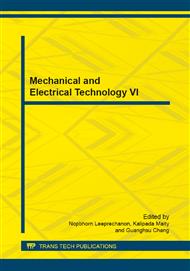[1]
S. Fish, UGV's in Future Combat Systems, Proc. of the SPIE-unmmanned Ground Vehicle Technology VI, Orlando, USA, 2004, pp.288-291.
Google Scholar
[2]
F. L. Menn, P. Bidaud, F. B. Amar, Generic differential kinematic modeling of articulated multi-monocycle mobile robots, Proc. of the 2006 IEEE Ineternational Conference on Robotics and Automation, Orlando, Florida, 2006, pp.1505-1510.
DOI: 10.1109/robot.2006.1641921
Google Scholar
[3]
C. Distante, G. Indiveri, G. Reina, An application of mobile robotics for olfactory monitoring of hazardous industrial sites, Industrial Robot: An International Journal, 36/1 (2009) pp.51-59.
DOI: 10.1108/01439910910924675
Google Scholar
[4]
A. Meghdari, H. N. Pishkenari, A. L. Gaskarimahalle, S. H. Mahboobi, R. Karimi, A Novel Approach for Optimal Design of a Rover Mechanism, Journal of Intelligent and Robotic Systems, 44 (2005) pp.291-312.
DOI: 10.1007/s10846-005-9013-5
Google Scholar
[5]
K. Nagatani, A. Yamasaki, K. Yoshida, T. Adachi, Development and control method of six-wheel robot with rocker structure, Proc. of the 2007 IEEE International Workshop on Safety, Security and Rescue Robotics, Rome, Italy, (2007).
DOI: 10.1109/ssrr.2007.4381279
Google Scholar
[6]
R. Volpe, J. Balaram, T. Ohm, R. Ivlev, Rocky7: a next generation Mars rover prototype, Advanced Robotics 11 (1997) p.341–358.
DOI: 10.1163/156855397x00362
Google Scholar
[7]
R.A. Lindemann, C.J. Voorhees, Mars exploration rover mobility assembly design, test and performance, IEEE International Conference on Systems, Man and Cybernetics, Waikoloa, USA, (2005).
DOI: 10.1109/icsmc.2005.1571187
Google Scholar
[8]
B. Chen, R. Wang, Y. Jia, L. Guo, L. Yang, Design of a high performance suspension for lunar rover based on evolution, Acta Astronautica 64 (2009) p.925–934.
DOI: 10.1016/j.actaastro.2008.11.009
Google Scholar
[9]
D. Chugo, K. Kawabata, H. Kaetsu, H. Asama, T. Mishima, Step climbing omnidirectional mobile robot with passive linkages, Proc. of SPIEoptomechatronic Systems Control, Sapporo, Japan, (2005).
DOI: 10.1117/12.648372
Google Scholar
[10]
S. Nakajima, Development of four-wheel-type mobile robot for rough terrain and verification of its fundamental capability of moving on rough terrain, Proc. of IEEE International Conference on Robotics and Biomimetics, Bangkok, Thailand, (2009).
DOI: 10.1109/robio.2009.4913302
Google Scholar
[11]
R. Siegwart, P. Lamon, T. Estier, M. Lauria, R. Piguet, Innovative design for wheeled locomotion in rough terrain, Robotics and Autonomous Systems 20 (2002) p.151–162.
DOI: 10.1016/s0921-8890(02)00240-3
Google Scholar
[12]
S. Nakajima, Concept of a novel four-wheel-type mobile robot for rough terrain, RT-mover, Proc. of IEEE International Conference on Intelligent Robots and Systems, St. Louis, USA, (2009).
DOI: 10.1109/iros.2009.5354823
Google Scholar
[13]
F. Michaud, et al., Multi-modal locomotion robotic platform using leg-track-wheel articulations, Autonomous Robots 18 (2005) p.137–156.
DOI: 10.1007/s10514-005-0722-1
Google Scholar
[14]
M. Lacagnina, G. Muscato, R. Sinatra, Kinematics, dynamics and control of a hybrid robot wheeleg, Robotics and Autonomous Systems 45 (2003) p.161–180.
DOI: 10.1016/j.robot.2003.09.006
Google Scholar
[15]
T. Thueer, "Mobility evaluation of wheeled all-terrain robots, ETH, Zurich, DISS. ETH No. 18160, (2009).
Google Scholar
[16]
T. Thueer, P, Lamon, A. Kerbs, R. Siegwart, CRAB – Exploration rover with advanced obstacle negotiation capabilities, 9th ESA Workshop on Advanced Space Technologies for Robotics and Automation, Noordwijk, Netherlands, (2006).
Google Scholar
[17]
T. Thueer, A, Kerbs, R. Siegwart, Performance Comparison of Rough-Terrain Robots – Simulation and Hardware, Journal of Field Robotics Vol. 24, No. 3, pp.251-271, (2007).
DOI: 10.1002/rob.20185
Google Scholar
[18]
T. Thuerr, R. Siegwart, Mobility evaluation of wheeled all-terrain robots, Robotics and Autonomous System Vol. 58, pp.508-519, (2010).
DOI: 10.1016/j.robot.2010.01.007
Google Scholar
[19]
D. S. Apostolopoulos, Analytical Configuration of Wheeled Robotic Locomotion, Carnegie Melon University, USA, CMU-RI-TR-01-08, (2001).
Google Scholar
[20]
E. G. Papadopoulos, D. A. Rey, A New Measure of Tipover Stability Margin for Mobile Manipulators, IEEE International Conference on Robotics and Automation, Minneapolis, Minnesota, (1996).
DOI: 10.1109/robot.1996.509185
Google Scholar
[21]
K. Iagnemma, A. Rzepniewski, S. Dubowsky, P. Pirjanian, T. Huntsberger, P. Schenker, Mobile robot kinematic reconfigurability for rough-terrain, SPIE Proc. 4196, Symposium on Sensor Fusion and Decentralized Control in Robotic Systems Ⅲ Boston, USA, (2000).
DOI: 10.1117/12.403739
Google Scholar
[22]
D. Lachat, A. Kerbs, T. Thueer, R. Siegwart, Antarctica rover design and optimization for limited poser consumption, 4th IFAC-Symposium on Mechatronic Systems, Heidelberg, Germany, (2006).
DOI: 10.3182/20060912-3-de-2911.00136
Google Scholar


